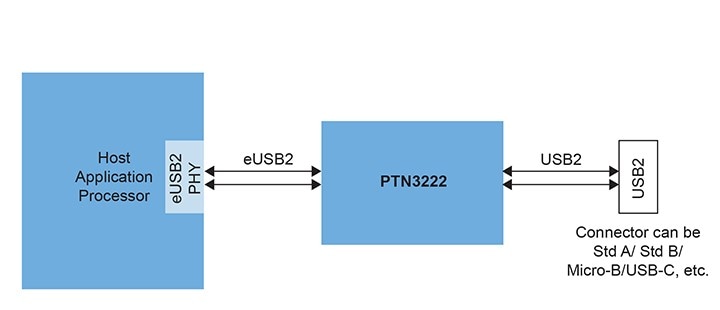The need for higher processing power and lower power consumption are driving processors and MCUs to more advanced process nodes
that are as small as 5 nm technology. For processors operating at 1.2 V supply that are suitable for mobile and computing
applications, as well as in traditional markets such as medical, industrial, and telecom, USB2 interfaces are a challenge. This
is because a USB2 interface operates at lower voltages, requiring a translator for seamless communication. Here are the top
three considerations to look for when selecting a USB redriver.
Signal Quality or Integrity
Customers with long PCB traces for USB2 interface will suffer signal quality/integrity issues without using a redriver. Long PCB
traces or long cables are typically used for USB2, then a redriver is required to ensure the integrity of the USB2 signals.
Size Limitations
Most applications have size constraints, such as a tiny form factor package which enables smaller solutions ideal for these
applications. NXP offers a 30% smaller IC, saving PCB space for size sensitive applications.
Flexibility
Multiple configurations exist for eUSB2 and USB2 application specific optimization. There are multiple settings for both Tx and
Rx on eUSB2 and USB2 signals, providing options to fine tune performance.
These top three considerations help for your ease of use. For example, you can plug any traditional type of USB into this device
and it will work properly, faster and more energy efficiently. NXP provides a default setting that is programmed into every part
before it is shipped. So, it should work in broad market applications, but it can also be optimized with register tables for
both eUSB2 and USB2.
 Additional markets include medical, industrial and telecom where USB2 interfaces are a challenge
Additional markets include medical, industrial and telecom where USB2 interfaces are a challenge
Support for Different Interfaces and Small Size
Our PTN3222 device supports both USB2.0 and eUSB2
v1.1. One of the main benefits is to interface low voltage microprocessors with USB2 peripherals.
This PTN3222 redriver is targeted for portable applications where size really matters. It is one of the smallest eUSB2 to USB2
redriver solutions on the market. The smaller size enables the end product to be smaller and allows more room for the battery
and other components.
As shown in the block diagram below, the PTN3222 is a standalone device.
USB2 interfaces can be challenging. NXP’s PTN3222CUK supports all three USB2 speeds. To get all the benefits of quality, size and flexibility for your design, order the
PTN3222CUK-EVB direct from NXP or your preferred distributor.
 Diagram showing how to connect NXP’s PTN3222 device
Diagram showing how to connect NXP’s PTN3222 device
Now that we have outlined the top three considerations when selecting a USB redriver along with the benefits for how this can
work, we hope that you can put our helpful PTN3222 device to work.



